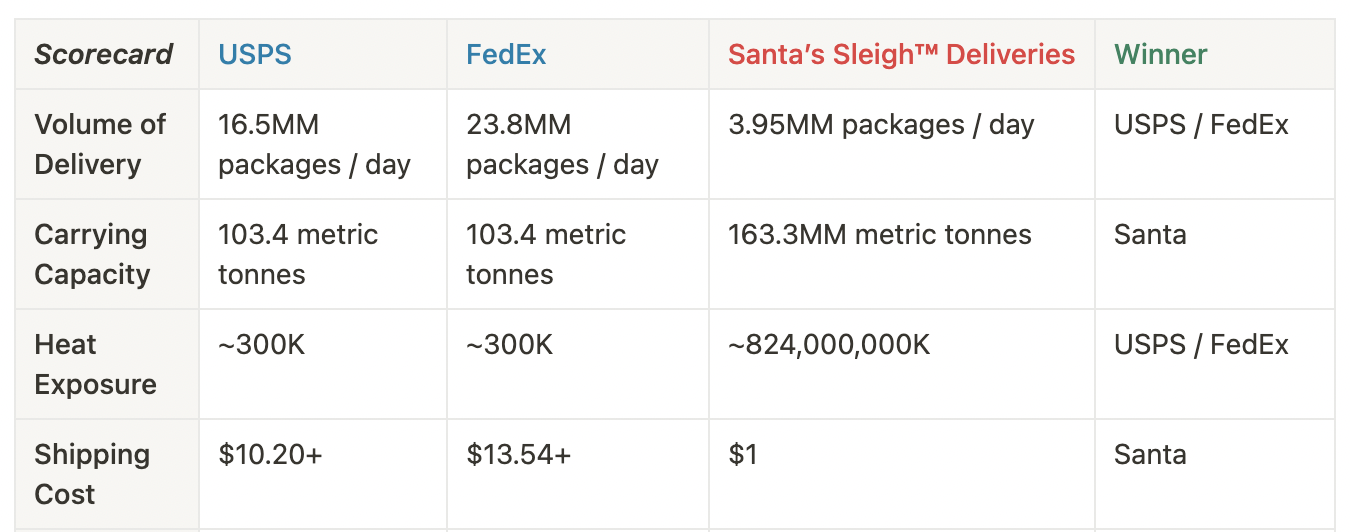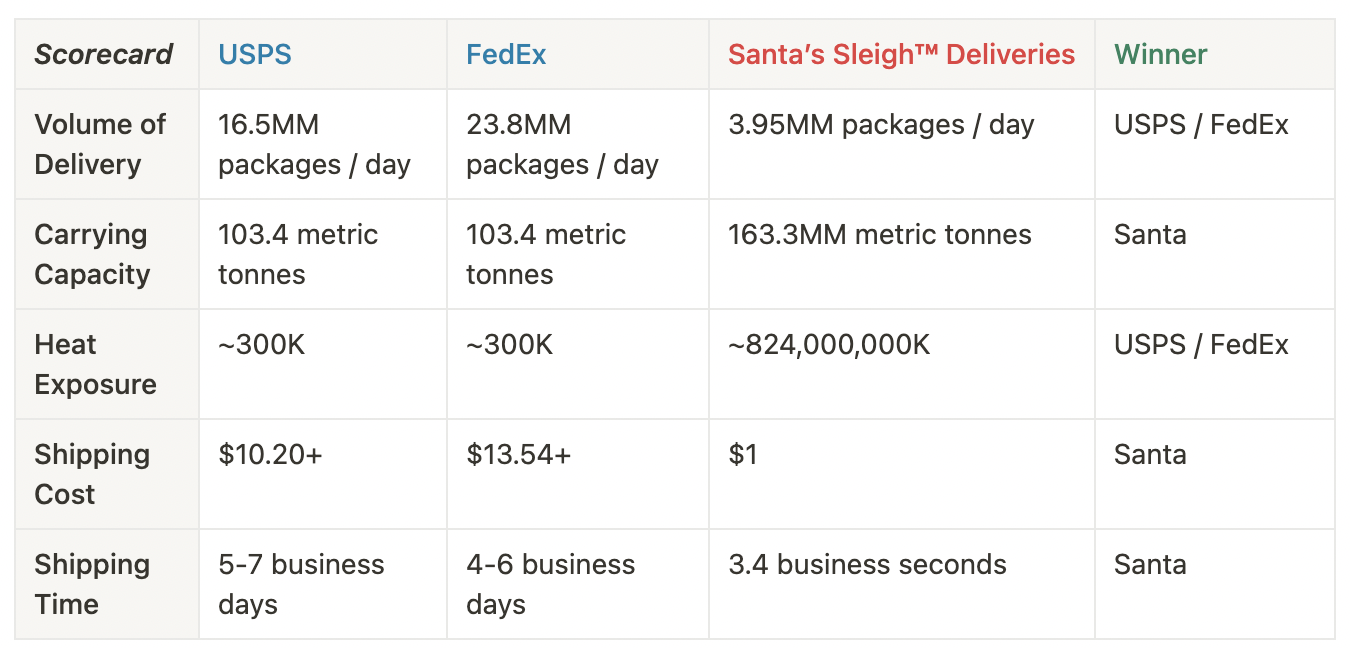Why you should consider Santa's Sleigh™ Deliveries for your next package [#29]
Can Santa compete with typical delivery services like USPS and FedEx?
![Why you should consider Santa's Sleigh™ Deliveries for your next package [#29]](/content/images/size/w1200/2023/07/29-clean.webp)
BREAKING NEWS: Santa has founded Santa's Sleigh™ Deliveries as an alternative to "traditional" delivery services like USPS and FedEx.
Santa said in a statement: "I deliver a ton of presents every year on Christmas night to good boys and girls all around the world. I figured that I might as well start my own delivery service!" He promises to improve upon the "boring" truck and plane-based system of delivery with his new (and IMPROVED) rocket-powered sleigh.
Let's compare Santa's Sleigh™ Deliveries to FedEx and USPS so we can decide whether Santa's Sleigh™ Deliveries is really worth it.
Volume of Delivery
Christmas is a Christian holiday, so let's assume that Santa only delivers to Christian children on the night of Christmas Eve. There are about 8 billion people in the world, and ~30% of them are Christian. Of those ~2.4B Christians, 30% (coincidentally) are under the age of 18. So Santa has ~720 million children¹ that he delivers to on the night of Christmas Eve.
If Santa gives two presents to each child, he has to deliver 1.44 billion presents. That's a lot of presents, but surprisingly, it doesn't even come close to the sheer volume of packages processed & shipped by typical delivery services. Let's make a scorecard to compare various attributes of USPS, FedEx, and Santa’s Sleigh™ Deliveries.

Sure, Santa delivers a billion or so presents on Christmas Eve, but he doesn't deliver any packages for the rest of the year. This allows USPS and FedEx to overtake Santa’s Sleigh™ Deliveries for the title of Volume of Delivery. After all, the more packages you can deliver, the better.
Carrying Capacity
Now if each present weighed an average of 4 ounces, and Santa had to carry all of the presents on his sleigh at once... Santa's sleigh would have to carry 163.3 million metric tonnes, which destroys the carrying capacity of the Boeing-747F (which can only carry 103.4 metric tonnes).

Santa obviously wins here. I never knew his sleigh could carry that much – maybe he's not lying about the rocket-powered sleigh.
Heat
Sure, airplanes are fast (~700mph), but how fast can Santa's sleigh travel?
720 million Christian children does not mean that there are 720 million Christian households. There's probably ~2 Christian children per household, so Santa only has to visit 360 million households. Light work, right?
Wrong. Santa actually has about 24 hours to complete his deliveries (because of the world's time zones). If we assume that households are, on average, spaced 0.25 mi apart², Santa has to travel 90 million miles in 24 hours, or 3.75 million miles per hour.
This is a bit of a problem for Santa.
If we assume that Santa's sleigh is composed of 1 metric ton of wood, we can calculate the temperature of the sleigh by calculating the kinetic energy and then using the equation for the specific heat capacity of wood. And it turns out that Santa's sleigh will heat up to a temperature of about 8.24 x 10⁸ K. That's only a little bit hotter than the Sun's surface temperature of 5800 K.
Santa may have a heat shield to protect himself from quadrillions of joules of energy, but I don't know if I'd trust him to deliver a delicate package. But pizza is probably okay – it would stay nice and warm on the trip to your house!

Shipping Cost
Shipping varies for USPS and FedEx based on the package you ship and when you want to ship it. But big organizations like USPS and FedEx employ thousands of people that they actually have to pay. Santa is a one-man job, so he doesn't have to charge as much as USPS and FedEx to still make a ton of money. (His elves are probably unpaid interns anyway.)

Even if Santa only charged $1 per delivery, he would make $1B+ in just one day. Plus, Santa is an altruistic guy, so he probably wouldn't charge more than a dollar or two.
Speed
The score is 2-2, so it all comes down to this. Who will win in a true test of speed?
Sure, it depends based on when you're ordering. If you order in the middle of March, USPS and FedEx will (probably) deliver your package before Christmas Eve comes. But what if you're one of the first to order right when the sun sets on Christmas Eve?
Since Santa can travel at 3.75 million miles per hour (or 1041 miles per second), he can travel anywhere on Earth in less than 12 seconds. If you're ordering a package to NYC, he'd deliver in about 3.4 seconds.

Now USPS and FedEx might appear to be "more reliable" and the "better option" if you're ordering in a month that isn't December. But consider this:
You're in NYC, shivering as you walk home on the night of Christmas Eve. You don't have enough money to pay for a taxi, and you're really craving food. You open up the Santa Eats app on your phone and order a large pepperoni pizza.
You instantly hear a deafening sonic boom as Santa's sleigh easily breaks the speed of sound. When you look down at the sidewalk again, you see an open box of warm, delicious pepperoni pizza. You look closely at the box and see a note from Santa saying "3.4 seconds is my new record!"
And that is an experience that no conventional delivery service will ever top.
Footnotes
¹ Of course, assuming all of those children qualify as "nice" on the nice / naughty list.
² It's impossible to get any good numbers on this. I think my estimate is reasonable, though, because it averages rural households (which are quite far apart) with tightly packed apartments.
![I never want to write another proof again [#68]](/content/images/size/w960/2025/02/hayley-maxwell-bdvycycdu-M-unsplash-2.jpg)
![A midnight business proposal worth $100,000+ takes an unexpected turn [#31]](/content/images/size/w960/2023/07/dmitry-demidko-eBWzFKahEaU-unsplash.jpg)
![Would you rather live an extra 25 years or get 1 billion dollars? [#20]](/content/images/size/w960/2023/06/100dollarbills.jpeg)
![How to choose an incredible Christmas gift [#7]](/content/images/size/w960/2023/06/kieran-white-SBdmQcW8qag-unsplash.jpg)